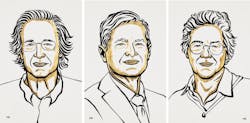2023 Nobel Prize in Physics recognizes methods to generate attosecond pulses of light
The three newest Nobel Laureates in Physics are: Pierre Agostini, a physics professor at Ohio State University, Ferenc Krausz, a professor of experimental physics at Ludwig Maximilian University of Munich and director of the Max Planck Institute of Quantum Optics (both in Germany), and Anne L’Huillier, a professor of atomic physics at Lund University in Sweden (see video).
The 2023 Nobel Prize in Physics recognizes their work creating extremely short pulses of light, which can be used to measure the rapid processes in which electrons move or change energy.
Fast-moving events flow into each other when perceived by humans, akin to the way a film that consists of still images is perceived as continual movement. If you want to explore blazingly fast events, it requires special technology. In the world of electrons, changes occur within a few tenths of an attosecond. For perspective, there are as many attoseconds in one second as there have been seconds since the birth of the universe.
The Laureates’ experiments produced pulses of light so short they are measured in attoseconds, which demonstrates these pulses can be used to provide images of processes inside atoms and molecules.
In 1987, L’Huillier discovered that many different overtones of light arose when she transmitted infrared laser light through a noble gas. Each overtone is a light wave with a given number of cycles for each cycle in the laser light. They are caused by laser light interacting with atoms in the gas—it gives some electrons extra energy that is then emitted as light. L’Huillier has continued to explore this phenomenon, which will lead to subsequent breakthroughs.
In 2001, Agostini succeeded in producing and exploring a series of consecutive light pulses, in which each pulse lasted just 250 attoseconds. At the same time, Krausz was working with another type of experiment that made it possible to isolate a single light pulse that lasted 650 attoseconds.
“We can now open the door to the world of electrons,” says Eva Olsson, chair of the Nobel Committee for Physics. “Attosecond physics gives us the opportunity to understand mechanisms that are governed by electrons. The next step will be utilizing them.”
Many potential applications can benefit. In electronics, for example, it’s important to understand and control how electrons behave within a material. Attosecond pulses can also help identify different molecules for medical diagnostics.
